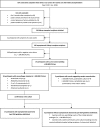Prevalence of asymptomatic bacteriuria among kidney transplant recipients beyond two months post-transplant: A multicenter, prospective, cross-sectional study
- PMID: 31490951
- PMCID: PMC6730876
- DOI: 10.1371/journal.pone.0221820
Prevalence of asymptomatic bacteriuria among kidney transplant recipients beyond two months post-transplant: A multicenter, prospective, cross-sectional study
Abstract
Background: During routine post-kidney transplant care, most European transplant physicians screen patients for asymptomatic bacteriuria. The usefulness of this strategy is debated. To make screening cost-effective, asymptomatic bacteriuria should be prevalent enough to justify the expense, and antibiotics should improve patient outcomes significantly if asymptomatic bacteriuria is detected. Regrettably, the prevalence of asymptomatic bacteriuria among kidney transplant recipients is not well defined.
Methods: To determine the prevalence of asymptomatic bacteriuria among kidney transplant recipients, we did a cross-sectional study among kidney transplant recipients undergoing routine surveillance in three outpatient transplant clinics in Belgium and France. We excluded patients who were in the first two months post-transplantation and/or had a urinary catheter. Asymptomatic participants who had a urine culture with one organism isolated at ≥ 105 CFU/mL were asked to provide a confirmatory urine specimen. Asymptomatic bacteriuria was defined per Infectious Diseases Society of America guidelines.
Results: We screened 500 consecutive kidney transplant recipients. Overall, the prevalence of asymptomatic bacteriuria was 3.4% (17/500 patients). It was similarly low among kidney transplant recipients who were between 2 and 12 months after transplantation (1.3%, 1/76 patients) and those who were farther after transplantation (3.8%, 16/424 patients: p = 0.49). Asymptomatic bacteriuria was significantly associated with female gender (risk ratio 3.7, 95% CI 1.3-10.3, p = 0.007) and older age (mean age: 61 ± 12 years [bacteriuric participants], versus 53 ± 15 years [non-bacteriuric participants], p = 0.03). One participant's colistin-resistant Escherichia coli isolate carried the globally disseminated mcr-1 gene.
Conclusions: Among kidney transplant recipients who are beyond the second month post-transplant, the prevalence of asymptomatic bacteriuria is low. Further studies are needed to ascertain the cost-effectiveness of a screen-and-treat strategy for asymptomatic bacteriuria in this population.
Conflict of interest statement
The authors have declared that no competing interests exist.
Similar articles
-
Antibiotics versus no therapy in kidney transplant recipients with asymptomatic bacteriuria (BiRT): a pragmatic, multicentre, randomized, controlled trial.Clin Microbiol Infect. 2021 Mar;27(3):398-405. doi: 10.1016/j.cmi.2020.09.005. Epub 2020 Sep 10. Clin Microbiol Infect. 2021. PMID: 32919076 Clinical Trial.
-
Host and microbial factors in kidney transplant recipients with Escherichia coli acute pyelonephritis or asymptomatic bacteriuria: a prospective study using whole-genome sequencing.Nephrol Dial Transplant. 2019 May 1;34(5):878-885. doi: 10.1093/ndt/gfy292. Nephrol Dial Transplant. 2019. PMID: 30304506
-
Epidemiology and outcome of antimicrobial resistance to gram-negative pathogens in bacteriuric kidney transplant recipients.Transpl Infect Dis. 2017 Aug;19(4). doi: 10.1111/tid.12722. Epub 2017 Jul 3. Transpl Infect Dis. 2017. PMID: 28486744
-
Asymptomatic Bacteriuria in Kidney Transplant Recipients-A Narrative Review.Medicina (Kaunas). 2023 Jan 19;59(2):198. doi: 10.3390/medicina59020198. Medicina (Kaunas). 2023. PMID: 36837399 Free PMC article. Review.
-
Targeting Asymptomatic Bacteriuria in Antimicrobial Stewardship: the Role of the Microbiology Laboratory.J Clin Microbiol. 2020 Apr 23;58(5):e00518-18. doi: 10.1128/JCM.00518-18. Print 2020 Apr 23. J Clin Microbiol. 2020. PMID: 32051261 Free PMC article. Review.
Cited by
-
Bacterial Colonization in Double J Stent and Bacteriuria in Post-Renal Transplant Patients.Cureus. 2022 Jul 31;14(7):e27508. doi: 10.7759/cureus.27508. eCollection 2022 Jul. Cureus. 2022. PMID: 36060333 Free PMC article.
-
Screening Biomarkers and Constructing a Predictive Model for Symptomatic Urinary Tract Infection and Asymptomatic Bacteriuria in Patients Undergoing Cutaneous Ureterostomy: A Metagenomic Next-Generation Sequencing Study.Dis Markers. 2022 Apr 28;2022:7056517. doi: 10.1155/2022/7056517. eCollection 2022. Dis Markers. 2022. PMID: 35531475 Free PMC article.
-
How to Treat Asymptomatic and Symptomatic Urinary Tract Infections in the Kidney Transplant Recipients?Cureus. 2020 Aug 7;12(8):e9608. doi: 10.7759/cureus.9608. Cureus. 2020. PMID: 32923210 Free PMC article. Review.
-
Recurrent Urinary Tract Infections and Asymptomatic Bacteriuria in Adults.Curr Bladder Dysfunct Rep. 2022;17(1):1-12. doi: 10.1007/s11884-021-00638-z. Epub 2021 Dec 1. Curr Bladder Dysfunct Rep. 2022. PMID: 34868442 Free PMC article. Review.
-
Profile, Risk Factors, and Outcomes of Asymptomatic Bacteriuria in Kidney Transplant Recipients with Normal Pretransplant Genitourinary Tract: A Single-Center Experience.Indian J Nephrol. 2024 Jan-Feb;34(1):37-44. doi: 10.4103/ijn.ijn_407_22. Epub 2023 Jun 5. Indian J Nephrol. 2024. PMID: 38645908 Free PMC article.
References
-
- Parasuraman R, Julian K. Urinary tract infections in solid organ transplantation. Am J Transplant. 2013;13(s4):327–336. - PubMed
Publication types
MeSH terms
Grants and funding
LinkOut - more resources
Full Text Sources
Medical


